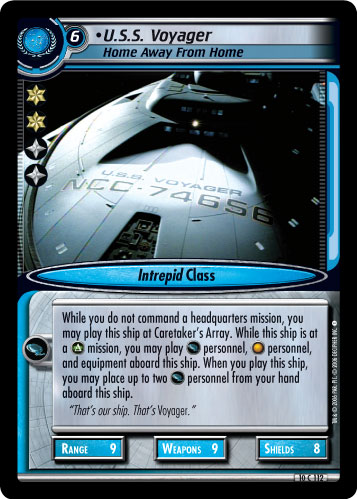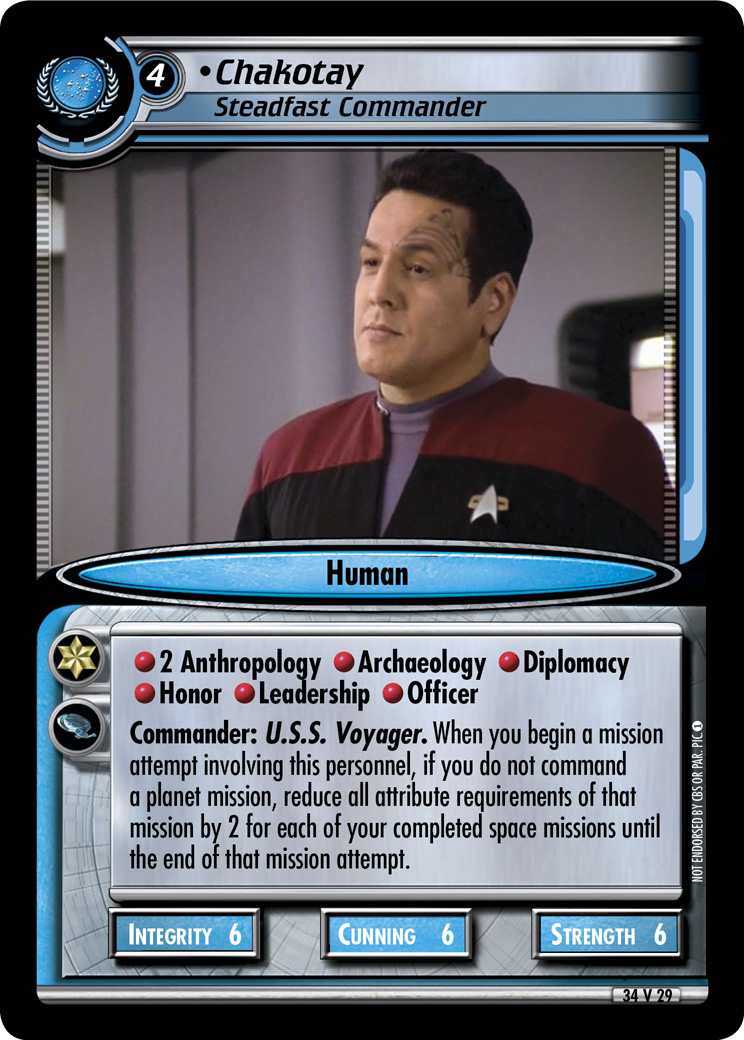All Categories • Continuing Committee • Organized Play • Rules Committee • Deck Designs • Virtual Expansions
Card Extras • Special Events • Tournament Reports • Everything Else • Spotlight Series • Contests
Strategy Articles
Design Spotlight: Second Edition Voyager
by Charlie Plaine, Chairman
30th May 2018
"We remembered the episodes, many episodes, where Q would show up and throw one of our ships or one of our people off to a strange part of the universe. And we'd have to figure out why we were there, how we were going to get back, and ultimately – by the end of an episode – we'd get back home. But [...] we started to talk about what would happen if we didn't get home. That appealed to us a great deal [....] You have to understand that Rick, Jeri and I had no interest in simply putting a bunch of people on another ship and sending them out to explore the universe. We wanted to bring something new to the Gene Roddenberry universe. The fans would have been the first people to criticize us if we had not brought something new to it. But everything new, everything was... a challenge, in the early stages of development of Voyager." - Michael Piller ("Braving the Unknown: Season 1", VOY Season 1 DVD special features)
Overview
The Voyager sub-affiliation of the Federation made their debut in 2006's Captain's Log. They were the seventh addition to the game's affiliations and sub-affiliations, and the second to rely on the Delta Quadrant in Second Edition. Voyager would be the first faction to care about ![]() missions as a mechanical hook. The sub-affiliation would gain a lot of power during the last few Decipher-era expansions that would continue into the CC-era.
missions as a mechanical hook. The sub-affiliation would gain a lot of power during the last few Decipher-era expansions that would continue into the CC-era.
At a Glance
Here's a quick look at the ![]() sub-affiliation:
sub-affiliation:
| Voyager |
|
| Nouns | 78 Cards (68 Personnel, 10 Ships) |
| Verbs | 15 Cards (8 Events, 7 Interrupts) |
| Missions ( |
28 |
| First Appearance | Captain's Log (2006) |
| Recent Appearance | Zero Hour (2017) |
| Appears In | Voyager |
| Doesn't Appear In | Enterprise, TOS, TNG, DS9, and Movies |
Strengths
In the modern Second Edition game, much of Voyager's power derives from their ability to avoid planet missions. Between their original 4-space variant (The Long Journey Home), and the updated Phase II version (Alsuran Sector (Utilize Abandoned Relay Station)), getting to avoid all of an opponent's planet dilemmas is a boon. This will only become more of a boon as power swings away from dual dilemmas back towards planet/space dilemmas, although offset slightly by more ![]() dilemmas being in dilemma piles. Even then, it's a trade off: having to complete four missions versus three. Voyager does have some powerful tools to mitigate that cost.
dilemmas being in dilemma piles. Even then, it's a trade off: having to complete four missions versus three. Voyager does have some powerful tools to mitigate that cost.
Mobile reporting is a big benefit to Voyager players. While it could lead to situations where one has more personnel aboard than they want (during a mission attempt, for example), it also means one doesn't have to travel back and forth from a headquarters mission. Managing Range is a huge cost for most decks, but it is minimal for Voyager players.
Mobile reporting - An ability, typically on a ship, that allows cards to be reported aboard the ship (or at its location) as if at a headquarters. U.S.S. Voyager (Home Away From Home) and Enterprise (Damaged Starship) are ship-based examples, though the mechanic has appeared on a personnel (Noonien Soong) as well.
Another strength of Voyager decks is the number of tricks they have available to them. As a Federation sub-affiliation, Voyager gains access to the common Federation tricks like "digging deep." Voyager players reigned high level play for some time with the combo of Chakotay and Revised Chakotay. Homeward Bound lets a Voyager deck get a bonus turn as long as they commit to all-space. They have a lot of tools, not to mention they're depth of skills and attributes while in the Delta Quadrant.
Weaknesses
Many of the strengths articulated above are double-edged, offsetting their advantage with potential disadvantages. Leaning into all space means you must attempt four missions instead of three, and an opponent leaning heavily on dual and space dilemmas will minimize the "no planet" benefit. Similarly, without a second ship in play, a Voyager deck can be forced to attempt missions with larger crews than they'd like.
If you drill down, you'll find that many of the Voyager sub-affiliation weaknesses have to do with their original design. Captain's Log was designed and developed right in the midst of Decipher's implosion due to executive misconduct, so there were far fewer resources to put towards the expansion. It's perfectly understandable, but it did leave the sub-affiliation somewhat unfocused mechanically. This would be addressed in turn by adding new, powerful cards that slotted into every Voyager deck. That's not a fun place to be, as most of the choices are taken away from a deck builder.
Similarly, designers spent years "going wide" with the affiliation - adding new themes/teams/mechanics - instead of developing a cohesive identity. This ended up fractioning the sub-affiliation into even smaller groups (Equinox, for example) and didn't address the fundamental issues. By the time Voyager received a Phase II update, in 2015's Lower Decks, it was nearly impossible to identify a cohesive identity to the sub-affiliation.
Looking Ahead
I think Voyager has been the victim of a series of mistakes, starting with their first cards and carrying on through today. I don't want to be critical of the people that made these decisions, because they were not made maliciously. When there was only one designer working on Captain's Log, there were going to be things missed. It's led to a hodgepodge of mechanics and themes that complicate the sub-affiliation for little gain.
Four-space Voyager should be embraced as the sub-affiliations identity, as it truly makes them unique. In a game with as many affiliations and sub-affiliations as Second Edition, it's truly rare to have a unique mechanic to tie to one of those factions. When we find one, we should embrace it. Voyager should double-down on the all-space identity and make it a defining trait, even if it means leaving other themes by the wayside. A lot of good can be done with an expansion or boutique of cards dedicated to fleshing out the all-space theme.
I find it really impressive that, in spite of the lack of mechanical focus, Voyager has managed to be one of the better decks in 2E's high level play. A lot of this is due to several marquee cards that have, for better or worse, hit with the errata bat. I'd like to see some time spent studying what made those mechanics valuable - aside from power - and expand them into Voyager (or into other affiliations, if it makes sense).
Finally, I'd like to see new missions added to the Delta Quadrant. We've learned that new missions, event "vanilla" ones with no extra game text, do wonders for deck diversity. Finding some underplayed personnel and creating matching missions, i.e. Kahmis and Rescue Prisoners, immediately offers new choices to deck builders. And that's exciting.
Conclusion
One of the few things I wish I could go back in time and change would be Voyager's introduction in Captain's Log. I admire and respect the work of the designers and testers of the time, but I don't think the sub-affiliation was done any favors without a firm identity in Second Edition. Going with Caretaker's Array instead of a headquarters was a bold move, but with the benefit of hindsight, it wasn't bold enough. Still, Voyager has had a lot of success over the years, so it's hard to be too mournful about their place in the game.
Discuss this article in this thread.
Back to Archive index













